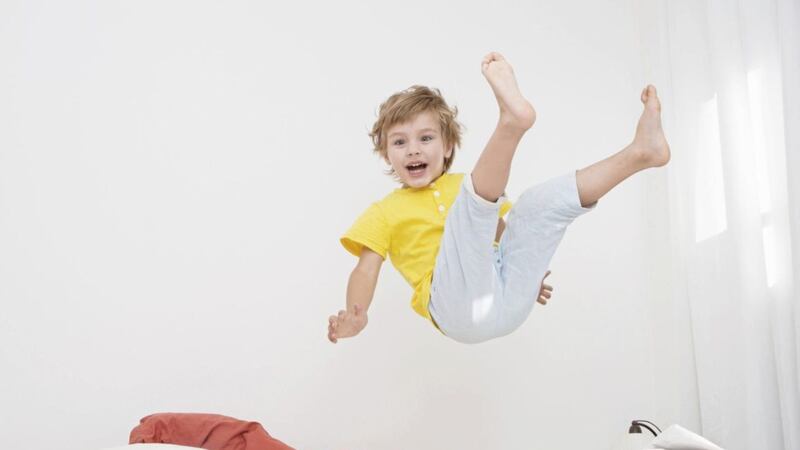MANY young children are still 'fizzy' at bedtime, and calming them before they go to bed can be an essential part of the parental toolkit. But how do you do it?
Mum and musician Lotte Mullan turned to 'disguised' mindfulness for kids when trying to get her three-year-old son to bed, and created Calm KIds, a series of six mindfulness stories to tame busy-minded and energetic toddlers.
"Calm Kids came about as a means to calm my feral toddler so he'd get to sleep," she says. "I tried more traditional mindful exercises, but as a wild three-year-old he couldn't have been less interested in sitting still and concentrating on breathing in and out. I had to find a way in with humour and the kind of slapstick silliness that appeals to toddlers.
"The characters captured my son's imagination enough for him to be oblivious to the fact that he was being lulled into a light hypnosis for slumber. I'm happy to report that said feral toddler is now somewhat tamed and goes to sleep at 7pm for 12 hours."
The stories, available free on streaming platforms, are read by Mullan and well-known voices including singer/songwriter Sophie Ellis-Bextor and Game of Thrones actress Bella Ramsey.
Mullan sneaked mindfulness techniques into the stories with the help of neurolinguistic psychotherapist Martin Weaver, who she worked with on the mindfulness album Calm Collective, and she also included specially designed music to lower the heart rate.
She adds: "Bedtime can be a battlefield with toddlers. Luckily, there are lots of simple activities you can do with your toddler to, if not tame them, then at least help them calm themselves (and you) down for a restful sleep."
Here she outlines seven ways to calm a toddler through bedtime mindfulness:
1. Ask them how they feel inside
When they're tired, children can become hyperactive, springing into life just as 7pm rolls around. If they're over-tired their body produces more cortisol and adrenaline to keep them awake. Encouraging your feral friend to zoom into how they feel inside their body ('becoming present') can really help those tiny twitching limbs unwind.
Try it together:
Stretch out your mouths and yawn like lions, see who can open their mouth the widest. Reaching your arms up to the ceiling, see how tall you can both be, before flopping back down. Wiggle your fingers and toes to release muscle tension and encourage your child to notice how it feels to be tense and then relax.
2. Laugh together
Humour is an important communication tool and when we're laughing our flight or fight response is turned off, which is vital for sleep.
Try it together:
Enjoy telling jokes or pulling funny faces. A favourite in our family is saying the name of an animal with your mouth closed and then the other person, through giggles, has to guess the name of the animal.
3. Magic breathing
Anxious or upset toddlers often hold their breath. Deep and concentrated breathing helps lower their heart rates and calms them, making them feel more in control.
Try it together:
Encourage your child to take a deep breath in, hold it for a few seconds and then breathe out a big sigh. It can be fun to think of breathing out every colour of the rainbow, blowing out birthday candles or naming any worries from the day and putting them inside bubbles, to be blown out into the sky where they'll pop.
4. Listen to relaxing music
Listening to relaxing music or sounds of nature like birdsong or waves has been proven to lower the heart rate and cortisol levels, creating a relaxed state for sleep.
Try it together:
Relax and listen to Calm Collective's Inner Calm (decca.lnk.to/InnerCalmWE) or Baby Sleep (decca.lnk.to/babysleepWE). See if your child can spot what each sound is and talk about a memory it may evoke.
5. Encourage children to notice what's around them
Mindfulness can be as simple as noticing what's happening in the present moment and giving it your full attention. Children are natural observers and encouraging them to connect to how they use their mind is a skill that can help with many challenges.
Try it together:
Take a cuddly toy at bedtime and ask your child to examine it closely; look at it, smell it, see what it feels like, and listen to the sound it makes against their ear.
6. Listen to your child
Allowing your child the space to be heard can help them express any hidden anxieties they've bottled up before it's time to settle down for sleep.
Try it together:
Ask specific questions: What was your favourite part of the day? When did you laugh the hardest? Try not to jump in with your commentary, and allow your child to draw their own conclusions about how they feel. Sharing personal stories at bedtime is just the first step in opening the channels of communication and trust between you.
7. Be with your toddler
Find ways to calm down and be with your toddler that don't involve screens. Mindfulness for kids is as much about mindfulness for parents. Being present in their company and tuning into their needs comforts them and lowers their heart rates, both of which encourage sleep.
Try it together:
The physical closeness of bedtime stories encourages that all important hormone oxytocin, and sharing stories is a way to experience other people's worlds and inspire empathy. If you're too tired to read a story, listen to Calm Kids Bedtime Stories together.








